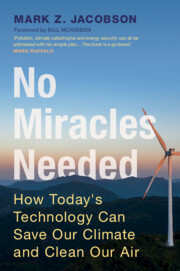Book contents
- No Miracles Needed
- Reviews
- No Miracles Needed
- Copyright page
- Dedication
- Contents
- Figures
- Foreword
- Preface
- 1 What Problems Are We Trying to Solve?
- 2 WWS Solutions for Electricity Generation
- 3 WWS Solutions for Electricity Storage
- 4 WWS Solutions for Transportation
- 5 WWS Solutions for Buildings
- 6 WWS Solutions for Industry
- 7 Solutions for Nonenergy Emissions
- 8 What Doesn’t Work
- 9 Electricity Grids
- 10 Photovoltaics and Solar Radiation
- 11 Onshore and Offshore Wind Energy
- 12 Steps in Developing 100 Percent WWS Roadmaps
- 13 Keeping the Grid Stable with 100 Percent WWS
- 14 Timeline and Policies Needed to Transition
- 15 My Journey
- References
- Index
11 - Onshore and Offshore Wind Energy
Published online by Cambridge University Press: 02 February 2023
- No Miracles Needed
- Reviews
- No Miracles Needed
- Copyright page
- Dedication
- Contents
- Figures
- Foreword
- Preface
- 1 What Problems Are We Trying to Solve?
- 2 WWS Solutions for Electricity Generation
- 3 WWS Solutions for Electricity Storage
- 4 WWS Solutions for Transportation
- 5 WWS Solutions for Buildings
- 6 WWS Solutions for Industry
- 7 Solutions for Nonenergy Emissions
- 8 What Doesn’t Work
- 9 Electricity Grids
- 10 Photovoltaics and Solar Radiation
- 11 Onshore and Offshore Wind Energy
- 12 Steps in Developing 100 Percent WWS Roadmaps
- 13 Keeping the Grid Stable with 100 Percent WWS
- 14 Timeline and Policies Needed to Transition
- 15 My Journey
- References
- Index
Summary
After solar energy, onshore and offshore wind energy have potential to supply the greatest portion of the world’s all-purpose energy demand. Not only are wind resources abundant in almost every country of the world, but the cost of onshore wind energy has also declined so much that wind in 2022 is the least expensive form of new electricity in many countries. Its low cost has resulted in massive wind installations to replace fossil-fuel power plants and to supply new energy demand. This chapter discusses the history of windmills and wind turbines followed by a discussion of the different types and components of wind turbines. The chapter also discusses how wind turbines work and how generators convert the energy from a rotating blade into electricity. Finally, the chapter discusses wind farm footprint and spacing areas needed to power the world, wind resources available worldwide, and the impacts of wind turbines on global wind speeds and temperatures as well as on hurricanes, birds, and bats.
Keywords
- Type
- Chapter
- Information
- No Miracles NeededHow Today's Technology Can Save Our Climate and Clean Our Air, pp. 233 - 260Publisher: Cambridge University PressPrint publication year: 2023

